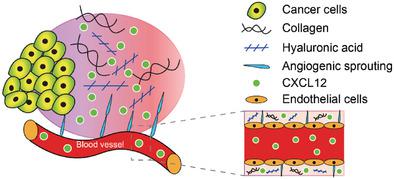当前位置:
X-MOL 学术
›
Adv. Healthcare Mater.
›
论文详情
Our official English website, www.x-mol.net, welcomes your
feedback! (Note: you will need to create a separate account there.)
Distinguishing Specific CXCL12 Isoforms on Their Angiogenesis and Vascular Permeability Promoting Properties.
Advanced Healthcare Materials ( IF 10.0 ) Pub Date : 2020-01-15 , DOI: 10.1002/adhm.201901399 Chia-Wen Chang 1 , Alex J Seibel 1 , Alex Avendano 2 , Marcos G Cortes-Medina 2 , Jonathan W Song 3, 4
Advanced Healthcare Materials ( IF 10.0 ) Pub Date : 2020-01-15 , DOI: 10.1002/adhm.201901399 Chia-Wen Chang 1 , Alex J Seibel 1 , Alex Avendano 2 , Marcos G Cortes-Medina 2 , Jonathan W Song 3, 4
Affiliation

|
Angiogenesis is associated with increased vessel sprouting and permeability. Important mediators of these angiogenic responses include local environment of signaling molecules and supporting extracellular matrix (ECM). However, dissecting the interplay of these instructive signals in vivo with multiple cells and extracellular molecules remains a central challenge. Here, microfluidic biomimicry is integrated with 3D ECM hydrogels that are well-characterized for molecular-binding and mechanical properties to reconstitute vessel-like analogues in vitro. This study focuses on three distinct isoforms of the pro-metastatic chemokine CXCL12. In collagen-only hydrogel, CXCL12-α is the most potent isoform in promoting sprouting and permeability, followed by CXCL12-β and CXCL12-γ. Strikingly, addition of hyaluronan (HA), a large and negatively charged glycosaminoglycan, with collagen matrices selectively increases vessel sprouting and permeability conferred by CXCL12-γ. This outcome is supported by the measured binding affinities to collagen/HA ECM, suggesting that negatively charged HA increases the binding of CXCL12-γ to augment its angiogenic potency. Moreover, it is shown that addition of HA to collagen matrices on its own decreases vessel sprouting and permeability, and these responses are nullified by blocking the HA receptor CD44. Collectively, these results demonstrate that differences in binding to extracellular HA help underlie CXCL12 isoform-specific responses toward directing angiogenesis.
中文翻译:

区分特定 CXCL12 同工型的血管生成和血管通透性促进特性。
血管生成与血管萌芽和渗透性增加有关。这些血管生成反应的重要介质包括信号分子的局部环境和支持细胞外基质(ECM)。然而,剖析这些指导性信号在体内与多个细胞和细胞外分子的相互作用仍然是一个核心挑战。在这里,微流体仿生学与 3D ECM 水凝胶相结合,该水凝胶具有良好的分子结合和机械特性,可在体外重建血管样类似物。本研究重点关注促转移趋化因子 CXCL12 的三种不同亚型。在纯胶原蛋白水凝胶中,CXCL12-α 是促进发芽和渗透性最有效的亚型,其次是 CXCL12-β 和 CXCL12-γ。引人注目的是,在胶原基质中添加透明质酸 (HA)(一种大的带负电荷的糖胺聚糖)可选择性地增加 CXCL12-γ 赋予的血管萌芽和通透性。测得的与胶原/HA ECM 的结合亲和力支持了这一结果,表明带负电荷的 HA 增加了 CXCL12-γ 的结合,从而增强其血管生成效力。此外,研究表明,在胶原蛋白基质中添加 HA 本身会降低血管萌芽和渗透性,并且通过阻断 HA 受体 CD44 可以消除这些反应。总的来说,这些结果表明,与细胞外 HA 结合的差异有助于形成 CXCL12 同工型特异性反应,以指导血管生成。
更新日期:2020-02-19
中文翻译:

区分特定 CXCL12 同工型的血管生成和血管通透性促进特性。
血管生成与血管萌芽和渗透性增加有关。这些血管生成反应的重要介质包括信号分子的局部环境和支持细胞外基质(ECM)。然而,剖析这些指导性信号在体内与多个细胞和细胞外分子的相互作用仍然是一个核心挑战。在这里,微流体仿生学与 3D ECM 水凝胶相结合,该水凝胶具有良好的分子结合和机械特性,可在体外重建血管样类似物。本研究重点关注促转移趋化因子 CXCL12 的三种不同亚型。在纯胶原蛋白水凝胶中,CXCL12-α 是促进发芽和渗透性最有效的亚型,其次是 CXCL12-β 和 CXCL12-γ。引人注目的是,在胶原基质中添加透明质酸 (HA)(一种大的带负电荷的糖胺聚糖)可选择性地增加 CXCL12-γ 赋予的血管萌芽和通透性。测得的与胶原/HA ECM 的结合亲和力支持了这一结果,表明带负电荷的 HA 增加了 CXCL12-γ 的结合,从而增强其血管生成效力。此外,研究表明,在胶原蛋白基质中添加 HA 本身会降低血管萌芽和渗透性,并且通过阻断 HA 受体 CD44 可以消除这些反应。总的来说,这些结果表明,与细胞外 HA 结合的差异有助于形成 CXCL12 同工型特异性反应,以指导血管生成。











































 京公网安备 11010802027423号
京公网安备 11010802027423号